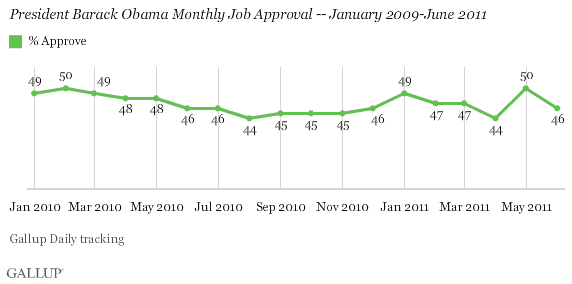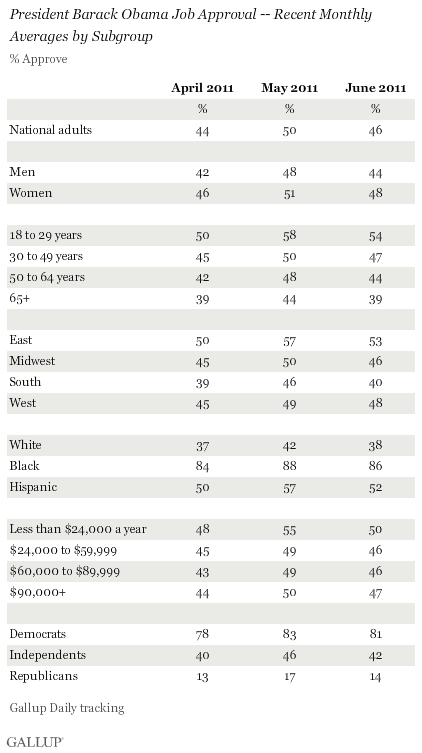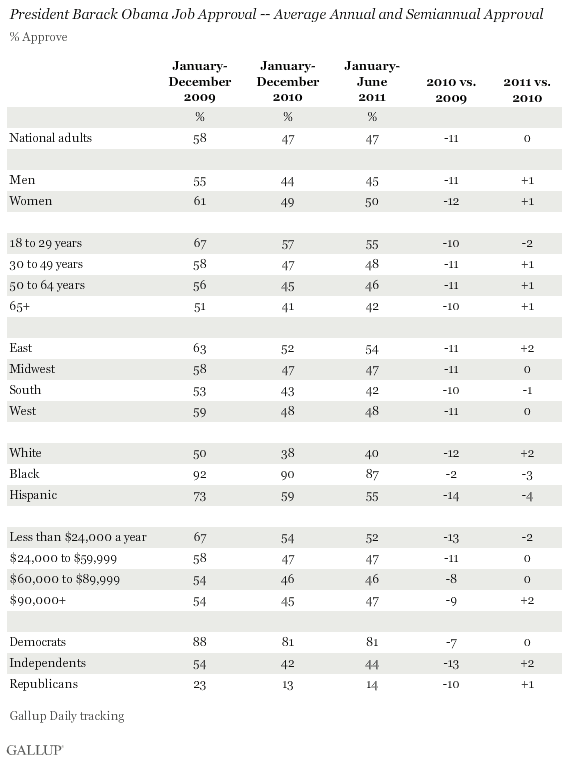PRINCETON, NJ -- President Barack Obama's job approval rating averaged 46% in June, down from 50% in May but similar to his ratings from February through April.

The president's approval rating rose in May after the May 1 announcement that U.S. forces had killed Osama bin Laden in Pakistan. It has since subsided about equally among all major demographic subgroups, reverting nearly to April's level.
Obama's strongest support continues to come from blacks (86%), adults aged 18 to 29 (54%), those living in the East (53%), and Hispanics (52%). This is in addition to 81% approval from fellow Democrats (as well as 75% from liberals and 55% from moderates, not shown here).
Republicans (14%), conservatives (24%), whites (38%), seniors (39%), and those living in the South (40%) are the least likely to approve of Obama

Average Approval Unchanged in 2011
Obama's average approval rating for the first half of 2011 -- 47% -- is identical to his average for all of 2010. Gallup also finds no major changes in various groups' approval of the president between these periods -- the largest is a four-point decline among Hispanics, from 59% to 55%.
The big shift in views of Obama's job performance occurred between 2009 and 2010, with his average approval rating falling 11 percentage points, from 58% to 47%. There was a slightly greater decline among whites and Hispanics, with virtually no change among blacks. Support also dipped more sharply among independents and Republicans than among Democrats.

Bottom Line
Public approval of how Obama is doing his job has been fairly steady in 2011, except for a temporary uptick after bin Laden's death. Furthermore, his average 47% approval rating in the first half of 2011 is identical to his average rating for all of 2010. The finding that the slide in his approval between 2009 and 2010 has since stalled could be viewed as a positive for Obama, particularly given ongoing challenges with the economy. On the other hand, his sub-50% approval rating may have contributed to the Democrats' losses in the 2010 midterm elections and would be less than ideal for Obama to maintain a year from now as he faces re-election.
Real improvement in the U.S. economy, including lower unemployment, would go a long way toward restoring approval to 2009 levels. Short of that, rebuilding approval among Hispanics, down 18 points since 2009, could be an important element of Obama's re-election strategy; however, he would need to do this while not further impairing his already tepid support among whites.
Survey Methods
Results are based on telephone interviews conducted as part of Gallup Daily tracking survey June 1-30, 2011, with a random sample of 15,344 adults, aged 18 and older, living in all 50 U.S. states and the District of Columbia.
For results based on the total sample of national adults, one can say with 95% confidence that the maximum margin of sampling error is ±1 percentage point.
Interviews are conducted with respondents on landline telephones and cellular phones, with interviews conducted in Spanish for respondents who are primarily Spanish-speaking. Each sample includes a minimum quota of 400 cell phone respondents and 600 landline respondents per 1,000 national adults, with additional minimum quotas among landline respondents for gender within region. Landline telephone numbers are chosen at random among listed telephone numbers. Cell phone numbers are selected using random-digit-dial methods. Landline respondents are chosen at random within each household on the basis of which member had the most recent birthday.
Samples are weighted by gender, age, race, Hispanic ethnicity, education, region, adults in the household, and phone status (cell phone only/landline only/both, cell phone mostly, and having an unlisted landline number). Demographic weighting targets are based on the March 2010 Current Population Survey figures for the aged 18 and older non-institutionalized population living in U.S. telephone households. All reported margins of sampling error include the computed design effects for weighting and sample design.
In addition to sampling error, question wording and practical difficulties in conducting surveys can introduce error or bias into the findings of public opinion polls.
For more details on Gallup's polling methodology, visit www.gallup.com.
